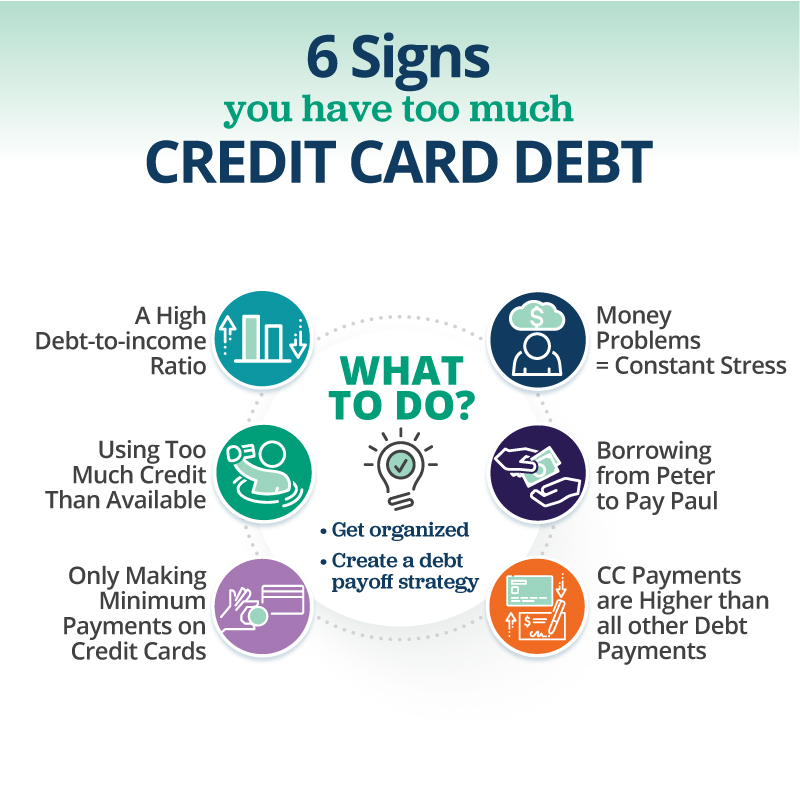
Taking on debt can help unlock a lot of opportunities. But having a lot of debt can signal financial stress. So how much is too much credit card debt?
How Much Debt is… Too Much?
The problem isn’t having debt, it’s not being able to pay it off. When debt no longer provides value, and instead is a burden, it can become too much to handle. Since everyone’s financial situations are different, there’s no magic number to determine if you have too much debt. But there are some indicators that can help you see where you stand. 6 common signals that someone may have too much debt include:
- A high debt-to-income ratio
- Using too much credit (High credit utilization)
- Struggling to make the minimum on credit card payments
- Borrowing money to pay bills
- Credit card payments are higher than all other bills combined
- Money is a constant source of stress in life

Before you read on, please know that we recognize everyone’s financial situations are different. We are providing this information about credit card debt to help you get a better understanding of your financial situation and to give you practical ideas on how to move forward. There is no such thing as too much debt as long as you are paying your bills and making progress on your financial goals.
- A High Debt-To-Income Ratio
Debt-to-income ratio, shortened to DTI, is a measurement used to understand how much debt someone has compared to their income. Creditors use DTI to help determine if someone qualifies for new credit. If someone has a high DTI, it may mean they are struggling to manage debt, or simply can’t take on more financial obligations. So what is a high DTI? Most financial experts agree that a DTI higher than 43% will make it hard to qualify for new credit.
You can calculate your debt-to-income ratio by adding all of your monthly debt payments and divide it by your gross monthly income.
- Using Too Much Credit That’s Available
Have you been close to maxing out a credit card recently? One of the signs of too much credit card debt is a high credit utilization ratio. If someone is using too much of their total available credit, it may signal to lenders that the person can’t afford the amount of credit they have.
- Only Making the Minimum Payment on Credit Card Balances
The general rule when using credit cards is to only use as much you can afford. So, if someone is just paying the minimum on high credit card balances, they may be struggling to pay off their total balance.
- Borrowing from Peter to Pay Paul
When someone is frequently moving money around just to pay off bills, it could be a sign that they are struggling to pay their bills and have too much debt. For example, if someone has grown a habit of opening up new credit cards after maxing out their old one, they may have too much debt.
- Credit Card Payments are Higher than All Other Debt Payments
One of the biggest indicators of too much debt can be figured out by comparing the debt you have. If your credit card payments are higher than all of your other debt payments, you may have too much credit card debt.
- Money = Constant Stress
If thinking about how you’re going to make your monthly payments is a constant source of stress in your life, it may be a sign of too much debt. While being stressed about money is normal every now and then, if money woes have not let up recently, it might be because there’s simply too much debt. Money stress can bubble up in several different ways, but one of the most common signs of stress is avoiding everyday expenses, like a dentist visit or utility payments.
What to Do If You Have Too Much Debt
Not having the money to pay your bills and balances can be scary. But there are actions you can take to help you get started on reducing debt.
Get organized
- Hit the reset button on your budget. Get a full picture of your finances and where your money is going. This can help you identify which debts you want to work on first.
- Know your credit score and debt-to-income ratio. Get a copy of your credit report and calculate your DTI so you’ll know where you stand.
- Understand the difference between debt that can help you and debt that won’t. Any debt that isn’t going to add value later in life (like a student loan or mortgage) is debt that you’ll want to prioritize to pay off sooner.
- Explore credit counseling as a way to learn more about money and get expert advice on how to manage credit card debt.
- Try to figure out the roots of your financial stress. Dealing with financial stress isn’t going to make your debt disappear, but, it can give you some closure, and potentially the confidence, to move forward.
Find a debt payoff strategy you can commit to
There’s a lot of choices when figuring out how you’ll actually pay off debt. Some of the ways to manage debt include:
- The debt snowball method
- The debt avalanche method
- Consolidate high-interest debt with a personal loan
This article is for educational purposes only and is not intended to provide financial, tax or legal advice. You should consult a professional for specific advice. Best Egg is not responsible for the information contained in third-party sites cited or hyperlinked in this article. Best Egg is not responsible for, and does not provide or endorse third party products, services or other third-party content.